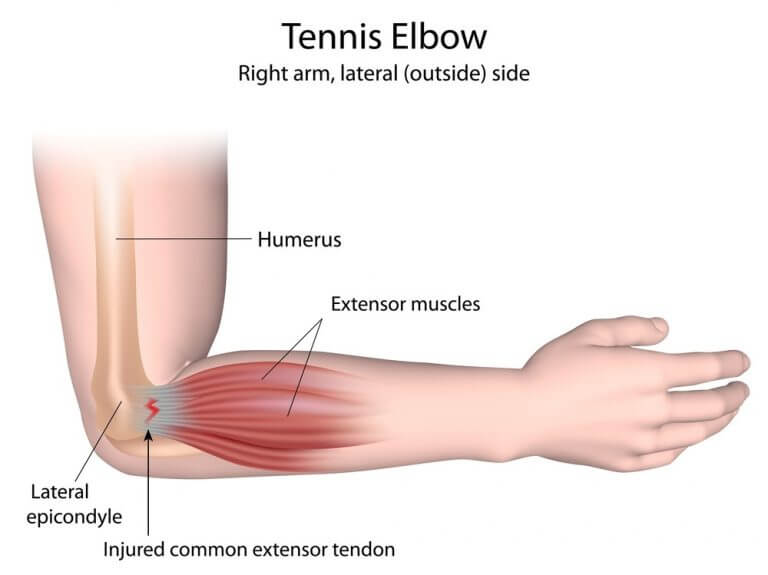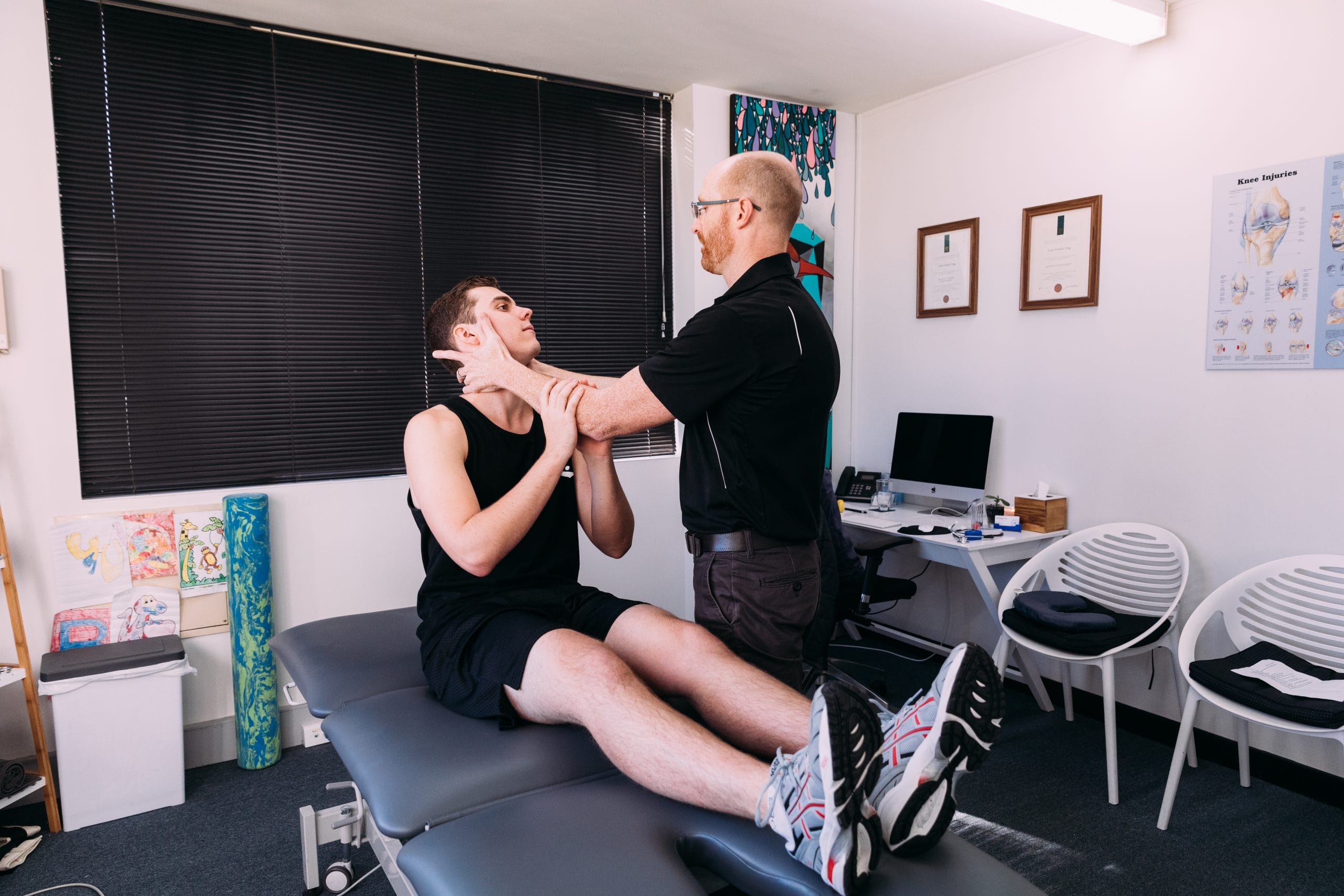
What Is Tennis Elbow?
Lateral epicondylitis, also known as tennis elbow, is a condition that causes pain in the area where the tendons from the forearm extensor muscles attach to the bony part of the outside of the elbow. This condition isn’t specifically associated with playing tennis. Tennis elbow is a condition that can be caused by overuse from a variety of causes.

The Symptoms Of Tennis Elbow
Tennis elbow causes pain on the outside of the elbow and may radiate to the forearm and wrist. Usually, the pain will come on gradually and repetitive wrist extension or forearm rotation may make the pain worse.
In some cases, there may also be swelling. Occasionally where there is nerve irritation, you may experience some neck stiffness or tenderness.
The Causes Of Tennis Elbow
Tennis elbow is caused by changes in the tendon fibres due to the overuse of the muscles in the forearm. The pain is caused by irritation to the tendon which connects the muscles in your forearm to the bone in your upper arm. These muscles allow you to extend your wrist backward. Tennis elbow is common in those between the ages of 35 and 55, although other age groups can also be affected.
Tennis elbow can be caused by playing tennis; however, this isn’t the only cause. Other activities where you use your wrist and forearm repetitively can cause tennis elbow, such as:
- Painting
- Gardening
- Other racquet sports
- Using manual or power tools
- Using a keyboard or mouse
Diagnosis Of Tennis Elbow
Diagnosing tennis elbow is usually done based on a physical examination and patient history. Sometimes x-rays may be used to rule out other causes of the pain, such as arthritis. Other imaging may be used, such as an MRI or ultrasound to investigate degenerative changes in the tendon, however, this is rarely needed.
Your physiotherapist will look for common symptoms associated with tennis elbow. The most common symptom being pain produced by the extensor muscles and pain on palpation of the lateral epicondyle. This pain may radiate along the upper arm or down towards the forearm. In rare cases, the pain may even extend into the third and fourth fingers. Your physio may also observe reduced flexibility and strength in the wrist extensor and shoulder muscles.
Tennis elbow often shows four stages in regards to the intensity of symptoms, these are:
- Mild pain a few hours after a provoking activity
- Pain immediately after a provoking activity
- Pain during a provoking activity and intensifies after the activity ceases
- Constant pain which interferes with any activity
A thorough assessment is essential to ensure the correct treatment plan is implemented. This will enhance the recovery process. It is also important that the assessment includes ruling out other causes.
Tennis Elbow Treatment
Tennis elbow sometimes gets better on its own, however, it can take anywhere from 6 months to 2 years. Tennis elbow is often a chronic condition that benefits from Perth physiotherapy treatments. Initially, tennis elbow treatment may involve ice application, pain relievers, and rest; or at least avoiding activities that aggravate the pain. A specific brace is often effective at protecting the tendon and reducing pain.
Physiotherapy is an effective treatment for tennis elbow. Your physio will teach you exercises that strengthen and stretch the muscles in your forearm. Your physio may also recommend the right brace to relieve stress on the painful area.
Common Physiotherapy Treatment Techniques
Your physio treatment will usually include hands-on techniques or dry needling and may include mobilisation of the elbow joint in some cases. This helps patients to resolve movement restrictions, reduce pain, and improve overall function.
There are many different physiotherapy treatments for tennis elbow. However, they all have the same goal; reduce pain, and improve function. Some of the general treatments include:
- Manual therapy
- Strengthening and stretching exercises
- Education and advice to control pain and modify activities
- Braces, straps or splints
- Medication in the short term
- Sports physio specific rehabilitation
How Effective Is Physiotherapy For Tennis Elbow?
Although tennis elbow can resolve on its own, this may take up to two years. Perth physiotherapy has demonstrated better outcomes for treating tennis elbow. Research has shown that there are benefits for pain reduction through physio techniques such as manual therapy and manipulation.
Studies have demonstrated that physiotherapy is more effective at managing the symptoms of tennis elbow when compared to steroid injections or advice alone. A six-week course of physiotherapy shows the majority of patients experiencing significant improvements after three weeks, with 60% or greater recovery after the six weeks of treatment. The improvements have shown to increase to 90% after 12 months.
In comparison, those who received advice alone had a delayed recovery time of six weeks to three months. Also, steroid injections are shown to provide good results initially. However, in many patients, the pain returned after about six weeks, and by three months had fallen behind the physiotherapy group. This delayed healing time and resulted in 30% more pain after 12 months compared to the other groups. For this reason, steroid injections are not recommended as a stand-alone treatment.
Physiotherapy is shown to be effective in both the short and long-term management of tennis elbow. The benefits of physio for tennis elbow include:
- Reduces pain
- Restores normal joint range of motion
- Restores function
- Facilitates tissue repair
- Restores normal muscle length and movement patterns
- Improves muscle strength
- Normalises cervical joint function
Tennis elbow is a very common overuse injury. The injury involves the extensor muscles in the forearm and causes pain near the bony part of the outside of the elbow. This pain may radiate further along the arm and even to the fingers in severe cases. Physiotherapy is shown to be an effective treatment for tennis elbow; and although tennis elbow often resolves itself, this can take a long time. Physio for tennis elbow improves recovery time by strengthening muscles, reducing pain, and improving overall function.




